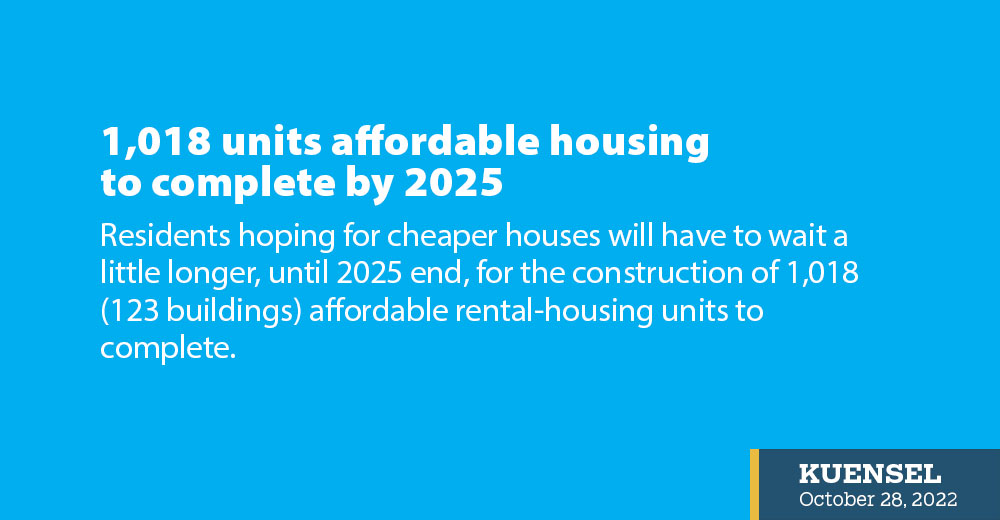Thukten Zangpo
Residents hoping for cheaper houses will have to wait a little longer, until 2025 end, for the construction of 1,018 (123 buildings) affordable rental-housing units to complete.
Chief executive officer of the National Housing Development Corporation Limited (NHDCL) Rinchen Wangdi said that the house rents would be highly subsidised. “It will be two times lower compared to the rents of the private buildings. It would not exceed 30 percent of a Bhutanese gross income.”
A study found that the majority of the Bhutanese face a moderate to severe rent burden paying more than 40 percent of their monthly household income.
The housing deficit has become critical, especially for middle and lower-income groups with about 58 percent of urban households residing in rented houses.
Affordable housing refers to access to housing whereby an occupant pays less than 30 percent of monthly household income towards rental expenses or servicing of mortgages and loans.
About 75 percent of the total or 724 units are to be constructed in Samtse and Phuentsholing.
Rinchen Wangdi said that the tender works for phase-I of construction in Phuentsholing with 120 units have been floated and work will begin soon.
He added that it will provide affordable housing to those Bhutanese residing across the border and those living in temporary shelters during the pandemic.
Rinchen Wangdi said that the construction modality in Phuentsholing and Samtse would be through new pre-engineered building technology where international contractors will bid for the work and local contractors can collaborate.
Since the 1980s, most of the buildings in Bhutan have been constructed with traditional reinforced concrete or wet construction with cement, sand and aggregates, he added.
“Phuentsholing housing units will have prefabricated structural steel framing. It will reduce the construction time by 50 percent and will lower the wastage,” Rinchen Wangdi said. It is expected to be completed by the third quarter of 2024.
Eight 2-storey buildings with 32 units in Trashiyangtse in traditional design are expected to be completed by the end of 2024. The tenders for the work have been floated.
Samdrup Jongkhar will see the construction of 15 buildings with 120 units and 8 buildings with 32 units in Nganglam. With tendering work to float next month, the construction will be completed by early 2025.
Thimphu will have 8 to 10 buildings with 110 to 120 units at nine different locations from Dechencholing to Babesa. By the end of 2025, the construction works are expected to be completed.
Rinchen Wangdi said that NHDCL is doing geotechnical studies and seeking clearances for other constructions.
However, he said there could be delays in the completion of the project because of the strict terms and procedures and in seeking approval from the donor.
The housing units are to be constructed with a total project cost of USD 37 million (M).
Asian Development Bank (ADB) will support with USD 24 M equivalent to a Nu 1.8 billion loan and a USD 6M (Nu 0.45B) grant at an interest rate of 1.5 percent annually with loan repayment until June 2028.
The government will pump in an additional USD 7M through a sovereign guarantee, which would be supported by the National Pension and Provident Fund at an annual interest rate of 7.5 percent with a repayment period of 20 years.
An additional USD 1M (Nu 75M) will also be provided by ADB as a grant for technical assistance to support the NHDCL in monitoring the uptake of housing units by target low-income groups.
Rinchen Wangdi said that the ADB has indicated that if the project goes well without default and overrun of costs and time, Bhutan will be eligible for the second phase. “Our overall plan is to build 2,500 units.”
The NHDCL wants to extend the affordable housing stock, he said. However, lack of funding is a challenge since borrowing from the market at high-interest rates is not a viable option, Rinchen Wangdi said.
The NHDCL and relevant stakeholders are also looking for a home-ownership modality to initiate.
As per the Population projections for Bhutan, 2017-2047, the urban population has increased from 30.9 percent in 2005 to 37.84 percent in 2017 and is projected to rise to 56.8 percent by 2047.


